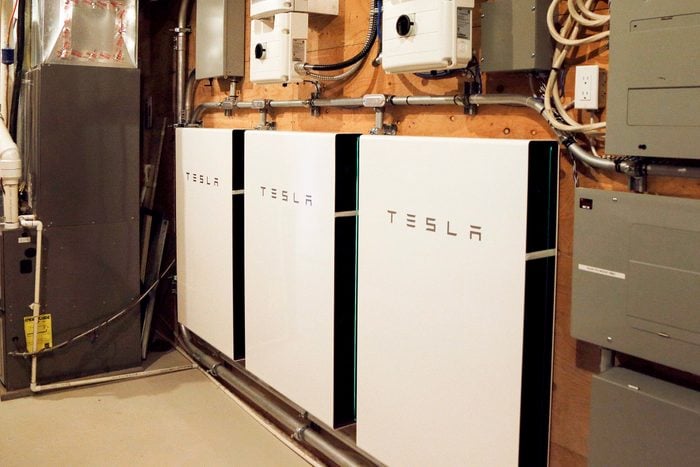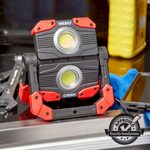What To Know About Solar Batteries

Solar battery technology has advanced in leaps and bounds in recent years. Here's what makes a battery a solar battery.
Tesla’s Powerwall, which the company began marketing widely in 2015, was the first significant application of lithium-ion technology to solar energy storage. Since then, several competitors have entered the market with products that are just as good or better.
This is good news for solar households. Battery technology is just as important as the panels themselves, which are becoming increasingly affordable and more efficient.
I moved onto my solar property in 2008. At that time, the battery bank consisted of 16 lead-acid monsters, each weighing 50 pounds or more and needing water every three months or so. Without that water, the batteries would dry up and die like plants, and a few did.
The inverter that converted the DC battery power to 120-volt AC power for the lights and appliances was a 200-pound behemoth. It practically broke my back when I hauled it all the way to Oregon for service after a lightning strike knocked it out.
Today’s solar batteries are not only lighter and longer-lasting, but many feature built-in inverters and charge controllers. That makes them smaller and easier to install. They’re also more efficient. Smart batteries can regulate themselves, remaining in charging mode while the sun is out and switching to discharge at night. This ensures an uninterrupted flow of electricity.
Also important to note, that as of January 1, 2023, tax credits for solar energy systems are now available. They were included as part of the Inflation Reduction Act that was passed in 2022. Homeowners can get a 30 percent tax credit on solar energy systems.
On This Page
What Are Solar Batteries?
As everyone knows, a battery is a device that stores electrical energy. These days, they’re almost everywhere. These features distinguish solar batteries from the rest:
- Chemistry: Most solar batteries incorporate some form of lithium-ion technology. Unlike alkaline or lead-acid batteries, they have no liquid electrolyte and can’t leak. Unlike nickel-cadmium (Ni-Cad) batteries, they aren’t toxic.
- Depth of discharge (DoD): Solar batteries are a type of deep-discharge battery, meaning they can safely be discharged almost completely before needing recharging. The minimum DoD for traditional rechargeable batteries is 50 percent, but the DoD of many solar batteries approaches 100 percent.
- Power rating: This shows how much energy you can get from the battery at one time, measured in kilowatts (kW). Besides a continuous power rating, many solar batteries have a five-minute instantaneous power rating as well. It’s measures how much power the battery can provide in short bursts. That’s important if you have a device that needs lots of power all at once, like a sump pump.
- Capacity: Measured in kilowatt-hours (kWh), this shows how much power the battery can store. Solar batteries generally have higher capacities than other types.
- Discharge rate (C-rate): Solar batteries have a higher discharge rate than ordinary rechargeable batteries. This means more of the battery’s stored power is available in the short term for operating appliances.
- Lifespan: Solar batteries typically last 10 to 15 years, longer than ordinary rechargeables.
- Maintenance: Most modern solar batteries are sealed and require no maintenance. Disposal isn’t usually an issue because most of their components are recyclable.
Types of Solar Batteries
If you categorize solar batteries by chemistry, there are three main types: lithium-ion, flow and lead-acid.
Lithium-ion batteries are the most common because they’re light and clean with lots of energy storage. There are two types: lithium nickel manganese cobalt oxide (NMC) and lithium iron phosphate (LFP). NMC batteries tend to be more powerful so they can be smaller, while LFP batteries last longer.
Flow batteries are generally industrial-sized and not currently an option for homeowners. Lead-acid batteries are reliable but, as mentioned above, more cumbersome and require more maintenance than lithium-ion.
Besides chemistry, there are four other ways to compare solar batteries:
- Integrated inverter: Some solar batteries require an external inverter (an extra expense), but many have built-in inverters and charge controllers.
- Coupling: Batteries can have AC or DC coupling, which means they can be tied to AC or DC loads. AC coupling is easier to install because the output can be fed straight into the electric panel. DC coupling, however, has better overall energy efficiency.
- Stackable: Some solar batteries can link up with additional batteries. This provides the flexibility of sizing a storage system according to your needs.
- Voltage: Solar batteries can operate at six, 12, 24 or 48 volts. Battery voltage must match that of the solar panels.
Solar Battery Pros and Cons
An off-grid solar property needs battery storage, but not necessarily a grid-tied one. A grid-tied solar generating system may feed electricity directly to the power company, and even when it doesn’t, the grid can function as a backup.
Nonetheless, grid-tied houses can benefit from batteries, although there are some drawbacks.
Pros
- Electricity during power outages: Quieter and cleaner than a generator, a solar battery provides power during storms, rotating outages and public safety outages. The latter are increasingly common in wildfire country.
- Lower energy costs: With a battery backup, you can turn off the power grid at time when electricity rates are higher, saving money.
- Ease load on the power grid: Any stored energy you use means less energy demand on the power company.
Cons
- Cost: Solar batteries aren’t cheap. Prices for full installation range from $6,000 to $20,000, and they don’t last forever. Warranty periods are typically 10 years or so.
- Increased complexity: You’ll need space for the batteries. And you have to add extra wiring and a transfer switch, so you can disconnect your panel from the grid when you’re on battery power during an outage.
- Environmental impact: Lithium mining negatively affects the environment. This is partially offset because most materials in solar batteries are recyclable, but it’s still a strategic problem as demand for lithium-ion batteries increases.



